 |
| Alachua Audubon Society studying gulls with Michael Brothers of the Marine Science Center in Ponce Inlet |
On February 1, the denizens of the Big Red Van rode over to Cedar Key, one of my favorite places in Florida. It's a quaint little fishing village that has survived both time and tide to become the ultimate contradiction - a sleepy tourist destination. Perhaps it's the out-of-the-way location or the lack of land on which to build, but the town has remained small and quiet despite the obvious attractions of sun and sea.
On this day, we had to deal with a heavy fog and very limited visibility. Nonetheless, our first stop was at Shell Mound, just north of town and in the Lower Suwannee National Wildlife Refuge. It can be a great spot for shorebirds, waders, gulls and terns. Unfortunately, the tide was low and the shorebirds were gathered in spots that were quite distant from us. Still, we were lucky enough to spot a Horned Grebe, always a pleasant surprise in this area.
Our typical second stop was the road to the airport where for many years the docks along the street were home to large congregations of birds. This allowed for close study and photography. However, a hurricane a few months ago wiped out all of the docks, and they have yet to be replaced. All I saw in that part of town was the Laughing Gull pictured above.
I'll happily admit that one of the highlights of birding in Cedar Key is the chance to visit a local restaurant. This time we stopped in the Big Deck Raw Bar. I had a Philly cheesesteak that was fantastic. I topped it off with ice cream from the little shop under Steamers. Delicious. While I ate my ice cream, I enjoyed watching the Brown Pelican pictured below.
As you can tell, by that time the fog was gone, but the day ended with fewer than 50 species. Still, a great meal, a Horned Grebe, and a few Marbled Godwits made the day a great one, so no complaints from me.
The next day I was fortunate enough to accept an invitation to Mike Manetz's house to see the Dark-eyed Junco that has been visiting his feeders. Admittedly, the photo below is poor. It was taken in really low light and from a little bit of a distance. Still, I haven't seen a junco in Florida for about eight years, so I was happy to see him at all. So pretend it's a clear shot and you're just a little tired or your glasses are dirty.
On February 7 I had the rare privilege of attending a lecture by Michael Brothers (below) of the Marine Science Center in Ponce Inlet. Michael is perhaps the leading expert on gull identification in Florida and one of the top experts in North America. His talk on that topic was incredible. Often, experts who know everything on a topic have a hard time talking to people who know very little. Michael is different. He was born to teach, and he does so with wonderful enthusiasm, patience and clarity. I took page after page of notes, and spent a bunch of time in the subsequent days comparing my notes and my field guides. Now I was ready to take it to the field!
The following Saturday found the Red Van Gang kicking off the morning at Blue Spring State Park in Deland. My goal was to walk out the Pine Island Trail a little way in hopes of finding some Florida Scrub-Jays. At first, I thought it would be a futile attempt. Very few birds showed themselves in the beautiful hardwood hammock at the beginning of the trail, and even fewer were seen in the open area once we emerged from the hammock. Then an Eastern Towhee popped into view:
Suddenly there was a chorus of towhees singing from all around us. It was pretty cool, but other than in the sky above us, the only other bird that we saw was a Palm Warbler:
Fortunately, we noted a spot where we thought we might have glimpsed and then heard a Scrub-Jay. So on the way back we stopped there and waited patiently. Soon an ever-curious Scrub-Jay wandered over to us to see just who it was that was disturbing his morning. This lovely bird, one that only exists here in Florida, should be our state bird. Look at the photo! What's not to love:
Back at the center of the park, we killed some time by strolling along the boardwalk and watching the manatees swim in the crystal clear water of Blue Spring. This one obliged me (below) by surfacing while my camera was ready.
Finally it was time for the whole purpose of the trip. Following Michael Brothers's talk to us, we were going to meet him at Frank Rendon Park in Daytona Beach Shores where we would try to apply what we had learned earlier in the week. The photo at the very top of today's blog depicts just a little more than half of the people who showed up to walk the beach with Michael and study the thousands of gulls that gather there late in the afternoon. In fact, this is the largest gathering of gulls in North America, and it happens every afternoon in the winter!
Now, I'm familiar with the adult plumage of the gulls I most often see - Laughing, Ring-billed and Herring. The Laughing Gull in today's second photo from Cedar Key is well on the way to its adult plumage. Soon its head will be all black and the white upper and lower "eye cups" will really jump out at you. Now here's an adult Ring-billed Gull:
Note that beautiful, clean vertical black ring around the bird's yellow bill. If only all gulls were named after - and prominently possessed - such obvious features! But no. Look at these two photos:
The bird in the lower photo is a Herring Gull. (No, I don't know why it's named after a fish, and I've never seen a Herring Gull eat a herring.) Now look at the brown bird in the center of the upper photo. It too is a Herring Gull, only at least on the surface, it looks very little like the stunning white, gray, and black of the other bird. The upper bird is a youngster in its first year, and its black bill and muddy brown features are the hallmarks of its age group. Only the pink legs seem to survive into adulthood, while the rest of the bird turns white and gray and the bill becomes yellow with a red spot. So Michael taught us also to look beyond the plumage at the size and shape. The Herring Gull really has a different shape, more elongated through the body and a little front-heavy. That was really helpful to hear and then see.
Here are two more birds to examine:
These two are Lesser Black-backed Gulls, a second year bird in the upper photo and an adult in the lower. To me, the Herring Gulls look almost like a football that is under inflated on the back end while the Lesser Black-backed Gulls are smaller and rounder when seen in profile. The dark gray of the adult can be picked out of a crowded beach pretty quickly. But the brown of the younger bird can get lost among other brown gulls. Fortunately, the size and shape really help, and even the brown of the second year Lesser Black-backed Gull is mixed with some deeper browns and grays making it darker than the other similar species.
Then there's this:
This one is a giant. It's the Great Black-backed Gull. I wish I had a good photo of a first or second cycle bird of this species for comparison, but I don't. However, the key here is that this is one really big gull. According to Sibley, they average 30" in length with a wingspan of about 65". By comparison the Herring Gull, typically thought if as a really big gull, averages 25" in length and its wingspan is about 58". Around here, this is the biggest gull on the beach, its sheer size making it a fairly easy ID. Here's another look at the Great Black-backed Gull:
Just as an aside, we saw thousands of gulls that day, but very few terns. Almost the only ones we saw were these two Royal Terns (below). They landed near the gulls, but basically kept to themselves.
I spent that night in Daytona Beach Shores, and after a fantastic breakfast at the Best Western, I made the drive to Oviedo and the Lake Jesup Conservation Area, East Tract. I hoped to spend a few hours birding the area and - if I were lucky - perhaps adding to my paltry Seminole County bird list. Upon arrival, the first bird to greet us was this cute little Eastern Phoebe:
The trail wound its way through some of the most gorgeous forest you could hope to find. Here's a shot of me trying to find a bird in the canopy. I was unsuccessful.
The trail is peppered with wild orange trees and honeysuckle shrubs that perfumed the clear morning air. The trail is well maintained and I enjoyed every minute in the park. However, on this day there were very few birds, and most of them were Yellow-rumped Warblers (below) or Ruby-crowned Kinglets.
I should also mention that the sky above seemed to be filled with Bald Eagles. I think I saw at least six, but probably more as several of the sightings were of adults and, well, they all looked alike.
Meanwhile, my plan was to reach the observation tower and use it to find throngs of great birds on and around the lake. Nice plan. The lake is very low right now, so it was quite a distance from the tower. Even scoping the lake was difficult as heat waves off the water distorted the view. Still we found White Pelicans and Great Egrets easily enough. And the pelicans proved to be a new county bird for me! At least one Great Blue Heron flew across the water, and I thought I had a glimpse of a Tricolored Heron. But the best looks that we had were of the many Common Yellowthroats (below) that surrounded us in the tall grass just in front of the tower.
So the first half of the month drew to a close. My numbers were relatively low - 85 species for the first two weeks - but my experiences were wonderful. The opportunity to study gulls with Michael Brothers was exceptional, and the walk around the property at Lake Jesup was beyond memorable. I'm planning to return there in fall migration when I think those same woods will be teeming with warblers. At least, that's the plan.

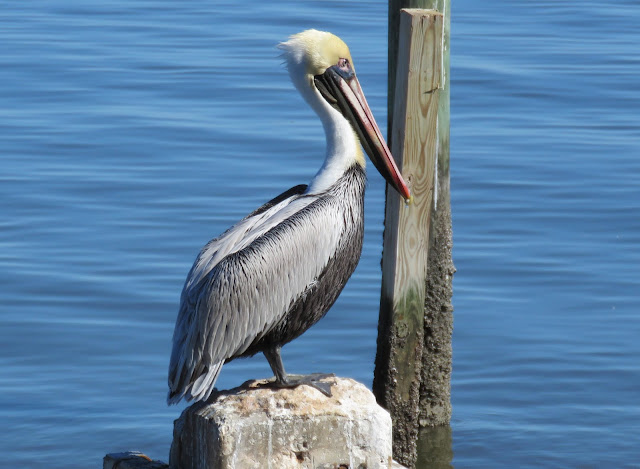

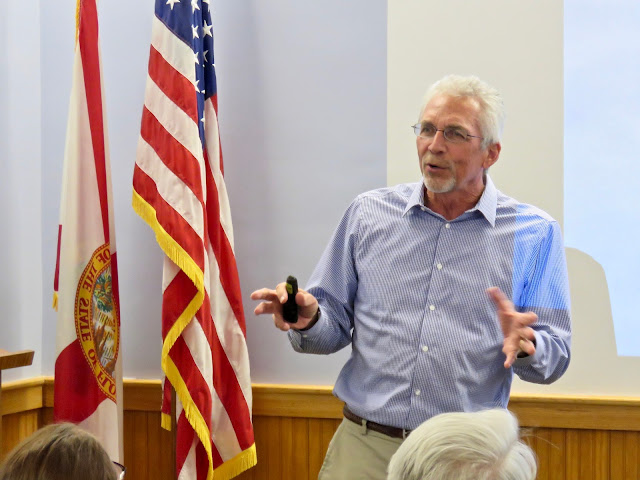

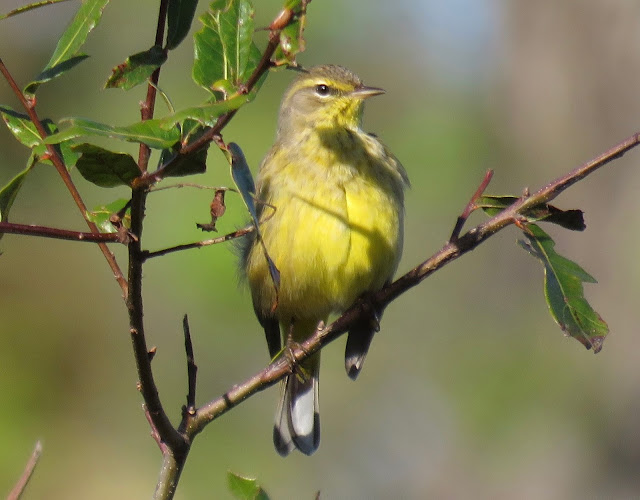


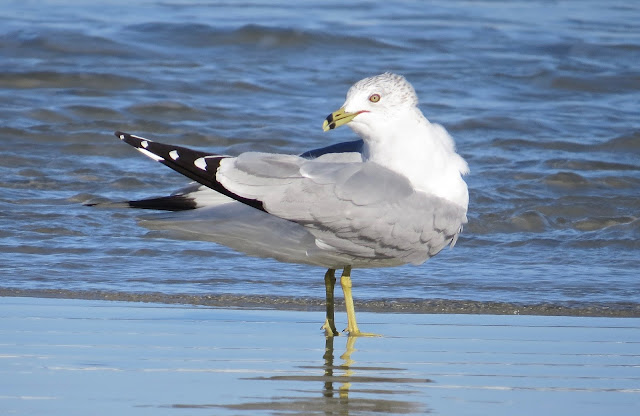


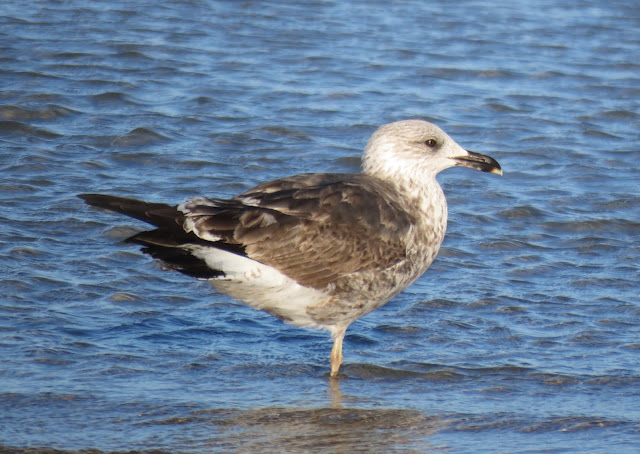



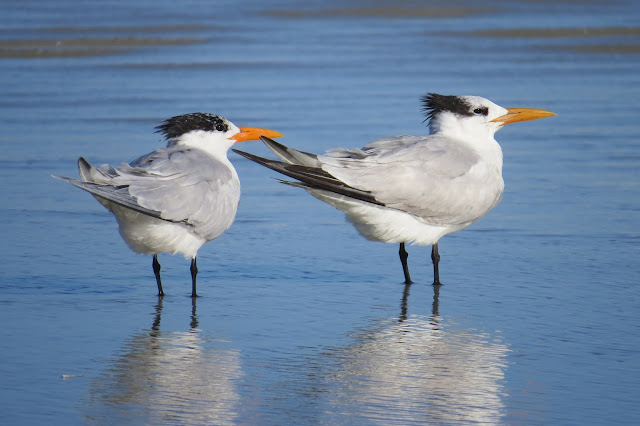




No comments:
Post a Comment
Tell me what you think!